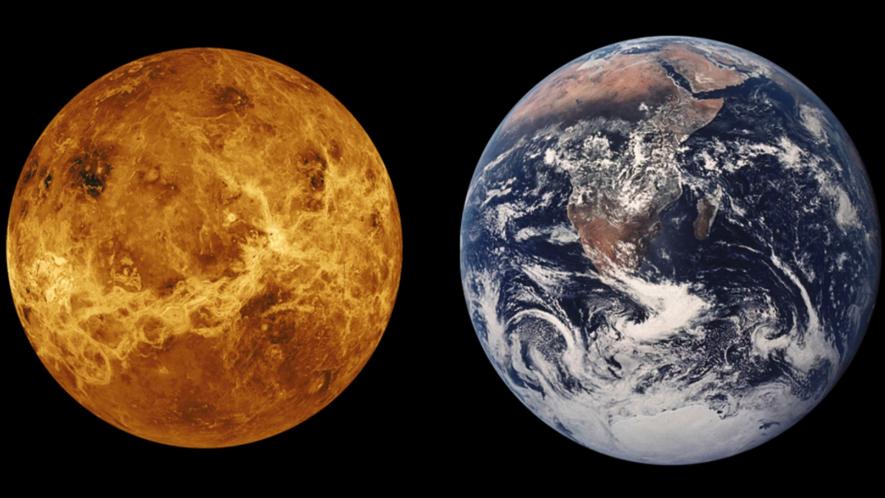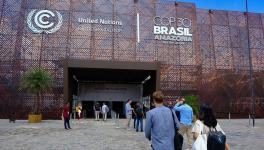Can a Habitable Planet Earth Turn into a Hot, Lifeless Sphere Like Venus?

Image taken from the internet, used for representation only.
Imagine planets Earth and Venus; one has beautiful oceans and lives, and the other is a lifeless, sterile sphere. Now, question whether a planet full of life like Earth can transform into a lifeless sphere like Venus. The answer is yes; scientists say that can happen with little changes in the temperature and luminosity of the Sun. Worth mentioning that Earth and Venus differ by only a few degrees in temperature.
In a recent research published in the journal Astronomy & Astrophysics, scientists could decipher the entire process which can transform a livable planet into a space more than harsh and hostile. The team of scientists from the University of Geneva and CNRS laboratories in Paris simulated (computer generated) the process known as the ‘runaway greenhouse process’ that can make the transformation happen. The research also showed that once the process starts, atmospheric structure and cloud coverage can undergo significant changes from the initial stages. This leads to a very complicated process, making the reversal almost impossible. The researchers suggest that if Earth witnesses a rise in temperature by just ten degrees coupled with a slight increase in the Sun’s luminosity, the process may get initiated, making the planet inhabitable.
The runaway greenhouse effect is the situation when greenhouse gases in a planet increase to such a level that the thermal radiation can not leave from the surface to space. Once started, this process is irreversible and can turn a livable planet into a harsh and hostile sphere.
The greenhouse effect, to a certain extent, is helpful; without this, Earth would have been an ice ball. In that scenario, as well, life would not have prevailed here. Water vapour plays a significant role in the process, which is also a greenhouse gas, preventing solar radiation absorbed by Earth from going back to space.
When too many greenhouse gases are present in the atmosphere, precisely when the amount of greenhouse gases exceeds a threshold, then it can increase the evaporation of oceans, which in turn increases water vapour in the atmosphere, and the process continues.
Speaking on it, Guillaume Chaverot, the lead author of the study, was quoted as saying in a statement, “There is a critical threshold for this amount of water vapor, beyond which the planet cannot cool down anymore. From there, everything gets carried away until the oceans end up getting fully evaporated and the temperature reaches several hundred degrees.”
The scientists’ team, with the help of a 3D global climate model and with the help of sophisticated computer tools simulated the entire process of transitioning a livable planet to an inhabitable one. Martin Turbet of CNRS laboratories, Bordeaux, Paris, while explaining about it, said, “ Until now, other key studies in climatology have focused solely on either the temperate state before the runaway, or either the inhabitable state post-runaway. It is the first time a team has studied the transition itself with a 3D global climate model and has checked how the climate and the atmosphere evolve during that process.”
The key point of the study is the finding of the development of a very peculiar cloud pattern, which increases the runaway effect and eventually makes it irreversible. According to Chaverot, as the process starts, very dense clouds are formed in the high atmosphere. This alters the atmosphere structure deeply. Commenting on a likely situation of Earth if the process begins, Chaverot explained, “Actually, the latter does not display anymore the temperature inversion characteristic of the Earth's atmosphere and separating its two main layers: the troposphere and the stratosphere.”
The findings will not only help understand the process but can be a key feature for the study of climate on exoplanets. The exoplanets are planets outside the solar system that are orbiting stars other than the Sun. One of the strongest points of exoplanet studies is to determine whether they can support life.
Scientists have calculated that even a small increase in solar irradiation and an increase in global temperature by just a few tens of degrees can initiate the runaway process, having the potential of transforming Earth into an inhabitable space like Venus.
The findings bore importance at a time when anthropogenic (man-made) climate change poses challenges to humanity and the planet as well. In the recently held COP 28, countries plan to restrict greenhouse gas emissions by human activities to limit the global temperature rise beyond 1.5 degrees Celsius per the Paris Agreement.
However, the team is not yet sure whether the increase in greenhouse gases alone can trigger the runaway process or whether an increase in solar luminosity can continue to drive the process.
Get the latest reports & analysis with people's perspective on Protests, movements & deep analytical videos, discussions of the current affairs in your Telegram app. Subscribe to NewsClick's Telegram channel & get Real-Time updates on stories, as they get published on our website.
























